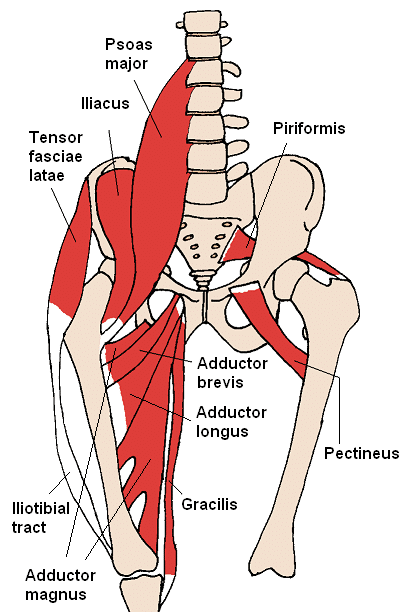Hernia and general surgeons will sometimes see these patients, who think maybe they have a hernia or a “sports hernia”. In most cases, patients should absolutely avoid surgery as initial therapy, and instead, these patients should be first referred to a specialist or a rehab program.
The hip adductors are a powerful muscle group. They consist of the adductor magnus, minimus, brevis, and longus. The gracilis and pectineus muscles also are included. All of the adductor muscles are innervated by the obturator nerve (L2-L4) except the pectineus, which is innervated by the femoral nerve (L2-L4). The adductor magnus also is innervated by the tibial nerve (L4-S3).

- Adductor magnus/minimus: origin is the inferior pubic ramus/ischial tuberosity; insertion, linea aspera/adductor tubercle
- Adductor brevis: origin is the inferior pubic ramus; insertion, linea aspera/pectineal line
- Adductor longus: origin is the anterior pubic ramus; insertion, linea aspera
- Gracilis: origin is the inferior symphysis/pubic arch; insertion, proximal medial tibia
- Pectineus: origin is the pectineal line of pubis; insertion, pectineal line of femur
Adductor muscle strain involves inflammation and pain along the inner thigh muscles and groin. These muscles allow the hip and leg to move across the body. Muscle attaches to pubic bone via tendon. The injury occurs at this junction between the muscle and tendon or at the tendon attachment to the pelvic bone. The strain may be a partial or complete tear of any or all of the adductor muscles.
An MRI will pick up adductor tears and sprains, which may also be associated with osteitis pubalgia, or even other simultaneous injuries.
These injuries can be graded. A grade I strain is a mild strain. There is a slight pull without obvious tearing (that is, the tearing is microscopic). There is no loss of strength, and the muscle and tendon are the correct length. A grade 2 strain is a moderate strain. There is tearing of fibers within the substance of the tendon, at the bone-to-tendon junction, or at the muscle-tendon junction. The length of the tendon or whole muscle-tendon-bone unit is increased, and there is usually decreased strength. A grade 3 strain is a complete rupture of the tendon off of the pubic bone.
Results from one study on adductor longus tears in NFL players are shown here: Fourteen NFL™ players were treated nonoperatively, and 5 players were treated with surgical repair using suture anchors. In both groups, all players eventually returned to play in the National Football League. Mean time for return to play was 6.1 ± 3.1 weeks (range, 3-12 weeks) for the nonoperative group and 12.0 ± 2.5 weeks (range, 10-16 weeks) for the operative group (P = .001). One player in the operative group suffered the complication of a draining wound and heterotopic ossification. Players represented a variety of positions, and 12 of 19 (63%) had experienced prior symptoms or events. (Reference = Theodore F. Schlegel, etal. The American Journal of Sports Medicine, Vol. 37, No. 7 2009). Nonoperative management includes NSAIDS with stretching and massage therapy, and a 3-6 week gradually progressive rehab program. Read more: https://www.harbinclinic.com/umages/pdfs/adductor.pdf
Watch video about adductor longus strain nonoperative management at https://www.youtube.com/watch?v=cDuzGs5_Pbk
General Management Algorithm:
If you have this injury, it is best to be referred to a physical therapist or rehab program who can design a gradual 3 – 8 week program for you. These programs will involve slow, but gradually more strenuous stretching and strengthening exercises designed specifically for you and your injury.
Rest from the insulting activity should last for at least 3-8 weeks depending on the severity of your injury, with gradual increase in activity as guided by therapist, rehab physician, or your care provider. Nonsteroidal anti-inflammatory medications, such as aspirin, Celebrex, and ibuprofen can be used with or without other minor pain relievers, such as acetaminophen. Take these as directed by your physician. Ice packs reduce inflammation for acute and chronic cases and are also useful. They can be applied every 2 to 3 hours for inflammation and pain and immediately after any activity that aggravates your symptoms. Heat may also be used before performing stretching activities.
Surgery is rarely necessary to re-attach tendons if it pulls off the pelvic bone. Surgery may be recommended if chronic, persistent pain exists at the groin for more than 3 months despite appropriate conservative treatment for strains, but this is rare. Unfortunately, suturing, or sewing, torn muscle is usually not successful. Likewise, usual hernia repairs for this injury do not often help.
For reference on above information and to read more about management:
https://emedicine.medscape.com/article/307308
Feel free to email us for an appointment or to aid in your diagnosis at nychernia@gmail.com




